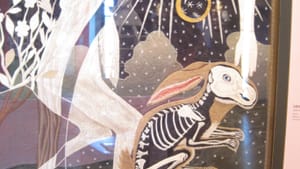Stay in the Loop
BSR publishes on a weekly schedule, with an email newsletter every Wednesday and Thursday morning. There’s no paywall, and subscribing is always free.
Who needs formal training?
Big Hope Show in Baltimore

Since it opened 20 years ago, Baltimore’s wild and wacky American Visionary Art Museum (AVAM) has become renowned for tackling ambitious subjects. This year’s sprawling, 20th-anniversary exhibition — The Big Hope Show — feels particularly relevant in these fearful times.
On the large panel of carefully crafted opening wall text, AVAM’s founder, Rebecca Hoffberger, calls the show the museum’s “most unabashedly idealistic” exhibit ever and notes that it “stars the radiant and transcendent qualities of hope.” Interestingly, she doesn’t specify what those qualities might be. The show, she implies, will make that clear. It doesn’t, but no matter.
AVAM’s mantra has never been “less is more,” and the Hope Show is no exception. The exhibition is stuffed with every manner of beaded, sequined, threaded, flashing, talking thing that could possibly be displayed on the museum’s second floor. Perhaps this bombardment is deliberate — a commentary on how each of us struggles to find hope amid the relentless demands on our time and attention in this Internet-obsessed era.
Whimsical cancer survivor
I fought to make peace with the mad swirl of sight and sound in the main exhibition room so that I could linger long enough to absorb the arresting “thread paintings” of Chris Roberts-Antieau, a cancer survivor. Particularly enchanting was a piece called Albino (above), which struck me as a visual hymn celebrating the deep connection between humans and the natural world. This connection is portrayed in delightfully whimsical ways: the rabbit’s body, for example, is depicted with the bones of its skeleton showing – a skeleton that looks remarkably like our own.
To create such large canvases of shimmering hand stitchery undoubtedly requires a spacious sense of time and a deep well of patience that itself may be the very foundation of hope. Nowhere is the relationship between patience, time, strength and hope more evident than in the contemplative room devoted to the story of the “dream house” created by Jackie Sumell for the incarcerated Black Panther Herman Wallace.
Convict’s dream house
Sumell, a graduate student, learned about Wallace at a 2001 lecture given by his fellow Black Panther Robert King, who had just been exonerated after serving a sentence of 31 years. Sumell contacted Wallace and asked, “What kind of house does a man who lives in a six-foot-by-nine-foot cell dream of?” Over the course of 12 years, Sumell committed herself to building that house, using ideas and instructions that Wallace mailed her.
{photo_2}
The exhibit’s centerpiece is a three-dimensional recreation of Wallace’s former cell; you can step inside it. Along the walls are selected letters from the pair’s correspondence— disarmingly honest and often effervescent. Especially moving are Wallace’s detailed drawings of the house that, as it turns out, he would never live in. Wallace was released from prison just three days before he died, after having been wrongfully imprisoned for 44 years, 41 of which were spent in solitary confinement.
Waiting for a transplant
In the end, I circled back to the opening room, wondering whether I had missed treasures in my haste to find quieter exhibit spaces. My return was rewarded: Near the entrance to the exhibit, easily overlooked, is a wall of business envelopes covered with intricate, colored-pencil drawings that the Vietnam veteran Philip Carey created while he underwent kidney dialysis.
Carey’s biography is as fascinating as his art: As a voice major at California State University, he roomed with the comedian Steve Martin. Later, he joined the Grammy-winning Gregg Smith singers, then spent 40 years designing and constructing exhibits for state parks in California and New York. In 2000 his wife died of breast cancer. Carey was diagnosed with heart disease four years later; in 2008, with kidney disease; and in 2011, with prostate cancer. Yet here they are: colorful and often hilariously cynical depictions of Carey’s life, created on the humble envelope. My favorite is a fanciful scene on which he’s written, “Mini-Philip Foraging in His Dialysis Goodie Bag.”
The good news? Last September, just as this exhibit was being installed, Carey received a new kidney after a 12-year wait.
If you’re hungry….
Too often, museumgoers – especially tourists – try to “blow through” an exhibit so that they can move on to other activities. In this case, I’d urge just the opposite. In fact, I’d suggest leaving the exhibit periodically to view pieces from AVAM’s permanent collection, remembering that the museum takes its name from its mission to showcase artists who lack formal arts training – individuals the museum considers “visionaries.”
If you need fortification, check out Encantada, the museum’s spacious new third-floor restaurant. Its imaginative décor is matched by an equally imaginative and delectable menu, including an array of small plates (I recommend the Crispy Brussels Sprouts, prepared with roasted garlic, aioli, lemon zest, and apple cider glaze). Encantada is set up for both serious diners and casual snackers, and it’s staffed by Baltimoreans who seem eager to make your visit to Charm City memorable. And don’t miss the gift shop: It’s filled to the rafters with items as cool and quirky as the museum itself.
What, When, Where
The Big Hope Show. Through September 4, 2016 at American Visionary Art Museum, 800 Key Highway, Baltimore, Md. (410) 244-1900 or avam.org.
Sign up for our newsletter
All of the week's new articles, all in one place. Sign up for the free weekly BSR newsletters, and don't miss a conversation.
 Marilyn Millstone
Marilyn Millstone